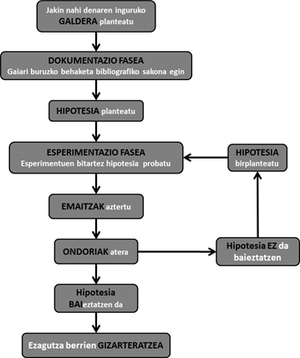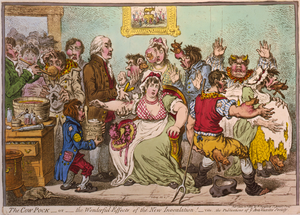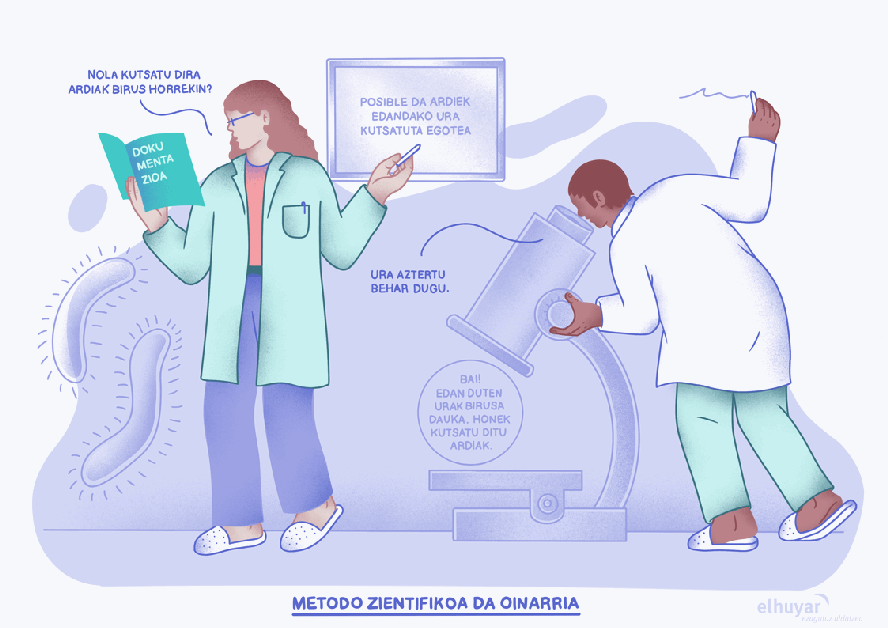10. It is based on the scientific method
To develop critical thinking it is necessary to know what is the SCIENTIFIC METHOD and the steps that this method has. So let's slowly see what the scientific method is.
The scientific method is a system that aims to generate knowledge, with different steps, and that verifies phenomena and empirical facts. In the scientific method observation is used to propose hypotheses and, through experimentation, contrast or cancel them. It is very important to socialize (publish) the knowledge generated by the scientific method, since these new knowledge can be complement or foundation of other knowledge.
Therefore, the scientific method is a set of techniques and procedures that help us advance knowledge, based on two fundamental pillars: repeatability (anyone with the necessary training and instruments can repeat observation or experiment) and falsification (our theories or hypotheses must predict results that, otherwise, would be denied).
As we have said, the scientific method is composed of several steps.
Question: The first step of the scientific method is to ask a question about what you want to know. Questions can arise from the observation of a natural phenomenon, the need to solve a problem or an unexpected discovery. In addition, new knowledge derived from other research, ideas exchanged with other scientists and reading scientific articles can generate new questions, thus building the basis for new research.
Observation (Documentation): Analysis of reality and knowledge of what you want to know, in order to understand something. The most common thing is to look for bibliography on the subject to be investigated. It is very important to carry out a thorough analysis to know the research that has been carried out around the subject and avoid unnecessary work.
Hypothesis: It is an idea that is proposed to explain what one wants to understand. The idea must be formalized in a well-founded hypothesis in order to be confirmed/cancelled experimentally effectively, since a bad hypothesis can mean a bad experimental design.
Experimentation: The experimental phase consists of the tests and experiments that are carried out to confirm the hypothesis. The experimental confirmation/cancellation of the hypothesis is the most important phase of the scientific method and depends on the proper design of the experiments, the selected variables and the measurement methods. Experimental misdesign does not serve and hinder the reproducibility of science (experiments must be repeatable to be valid).
Results analysis: The data obtained in the experiments must be analyzed to group, visualize and quantify the results. This allows debating the results and inferring evidence-based conclusions. To carry out a thorough analysis of the results it is necessary to use the statistics.
Conclusions: The conclusions, based on the theory resulting from the analysis of the results obtained, serve to accept, transform or reject our hypothesis. If the research results match the hypothesis, we will move on to the next step. If the conclusions do not confirm the hypothesis, it should be reconsidered.
With the new hypothesis, a new experimentation must be designed and carried out, the results are reviewed, and conclusions that confirm the second hypothesis can be inferred.
Socialization of generated knowledge: If the knowledge generated is not socialized, it is useless. Scientific knowledge is constructed through the communication of the results obtained and must be done accurately and reliably. Research results are published through articles from scientific journals. All articles go through a valuation method in which expert scientists in the field evaluate the vulnerabilities of the article and suggest their acceptance, review or rejection.
But scientific and technological knowledge should not only be in the hands of experts, so it is very important to socialize scientific-technological knowledge through scientific disclosure. This will develop the critical thinking of society, fostering the participation of society in the development of science and technology.
So important is the socialization of scientific knowledge, which is mentioned in Article 27 of the Universal Declaration of Human Rights adopted by the United Nations General Assembly on December 10, 1948 at the Palais Chaillot in Paris, France.
“Everyone has the right to participate freely in the cultural events of the community, to enjoy artistic works and to participate in scientific progress and the advantages that derive from it”
The following figure shows a diagram of the steps that are followed in the scientific method:

An example of scientific method: The vaccine by Edward Jenner and Baztanga.
Because of the SARS-Cov-2 virus pandemic, many researchers around the world work against the clock in search of a vaccine that protects us against the disease. These research laboratories that are developing the vaccine use the scientific method. But current researchers are not the first to use the scientific method to develop a vaccine against a disease. For example, the prestigious English researcher, physician and poet Edward Jenner (1749-1823), founded on the scientific method, caused millions of deaths and was eliminated by vaccination to develop a vaccine against the first viral disease. The smallpox vaccine.
In Jenner's time, smallpox was a very dangerous disease for humans, causing death to a high percentage of people infected with the virus. In addition, the survivors were left forever with the scars of the wounds caused by the disease, causing in the most serious cases blindness.
However, smallpox from cows was a mild disease that could infect humans from animals. It was common for cowboy workers, touching the wounds of the udders of the affected cows, to get infected with the smallpox of the animals. But when this type of contagion occurred, the sick were quickly cured and did not become so easily infected with human smallpox. Based on what was previously seen by other physicians, Jenner's work was instrumental in understanding the disease inoculation procedure and its successful application and developing the smallpox vaccine. Jener's steps in applying the scientific method were:
Observation: They observed that among workers who were infected with marginally ill animals in dairy farms, the effect of human smallpox was less, so they consulted information on previous work.
Hypothesis: He hypothesized that people contaminated with cows' smallpox generated immunity from human smallpox.
Experimentation:
In May 1796, Sarah Nelmes, a cowboy worker, asked about a wound in her hand and, after analyzing Sarah, Jener diagnosed her with cows smallpox.
Edward Jenner realized that it was a good opportunity to demonstrate the protective characteristics of cows' smallpox against human smallpox and therefore confirm their hypothesis.
For the experiment, he needed someone who had never suffered from the smallpox of cows and smallpox of humans and chose James Phipps, the 8-year-old son of his gardener.
Jener surprised James in an arm and rubbed the material from the wounds of Sarah's hand.
After a few days, James became ill with smallpox of cows, but after a week he was completely formed and had no symptoms of disease. In this way, Jenner assured that the smallpox of cows could pass from animals to people and from one person to another.
The next step was to check if the cows' smallpox would protect James from the man's smallpox, and Jenner put the child in contact with the man's smallpox (with a process similar to the one he did to catch the cow's smallpox).
Results Analysis: As Jenner advanced, James did not develop human smallpox either in this test or in other subsequent tests to test immunity. Jenner repeated the experiment with many other people and confirmed the repeatability of his experiment.
Conclusions: He confirmed his hypothesis. If a person spreads and cures himself with the smallpox of animals, he protects himself against the smallpox of man.
Socialization of generated knowledge: In 1798 he published in a book all his research on smallpox and in the following two years published the results of other experiments stating his theory that smallpox cows protected against human smallpox.
Baztanga vaccine movement
As is the case today, at the time of Jenner there was also an anti-vaccine movement and there were movements against the smallpox vaccine he found. The members of these movements said that vaccinated people would develop the characteristics of cows, but they did not use the scientific method to make these claims and could not demonstrate what they said with evidence-based reasons.
The following figure shows the figure of the British satirist James Gillray to caricature the controversy caused by the smallpox movement (The Cow Pock or The Wonderful Effects of the New Inoculation (James Gillray, 1802).

The cartoon published by Gillray in The Punch magazine in 1802 depicts a scene to inoculate Jener's vaccine at Saint Pancras Hospital in London. In the center of the image appears Jenner vaccinating a woman sitting. On the right appear vaccinated people who are removing parts of the cows in the body.
Can the scientific method help solve everyday problems?
The scientific method is used to create new knowledge, but it can also serve to solve problems or doubts of our day to day and often we use it unconsciously. The following paragraph presents a situation that can occur to anyone at any time:
“You have heard that the case of covid-19 has gone up in Euskal Herria and, wanting to see the latest news that will be given on Teleberri, as soon as you enter the remote control button at home and have turned on the television. However, television does not turn on. How would you apply the scientific method to know what happens?
A possible answer:
Note: when you try to turn on the TV with remote control it does not turn on.
Hypothesis I: TV is disconnected.
I Experimentation: approach the connection and see if the cable is connected or not.
I Analysis of results: television is connected.
I Conclusions: it is not a connection problem. Rethink the hypothesis.
Hypothesis II: the batteries of the remote control have been exhausted.
Experimentation II: Since you don't have new batteries at home, you have removed the batteries to the kitchen radio and put them in the control and you have tried if you turn on the television.
II Analysis of results: TV is lit.
II Conclusions: the batteries of the command are exhausted. Hypothesis 2 is confirmed.
Socialization of results: Write down the TV remote control batteries in the home shopping list.
With the example above it can be observed that the scientific method is very useful to solve the problems that are presented to us in our daily life and that many times we use it without realizing
The scientific method is also very useful for the development of critical thinking; many times we use it as a tool to analyze whether an information that comes to us is credible or not.
To download the document click here.






